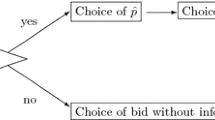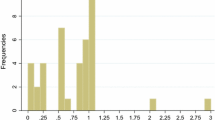Abstract
The acquisition of information is an important feature in most auctions where one’s exact private valuation is unknown ex-ante. We conducted the first experiment in testing a risk-neutral expected surplus maximization model with this feature. Varying the auction format and the cost of information acquisition we found bidders in most cases acquired too much information. Moreover, bidders who remained uninformed placed bids significantly below the optimal bid. The general prediction concerning revenue and efficiency remains valid, as a higher information cost was associated with lower revenues and efficiency rates. We explore different ex-post explanations for the observed behavior and show that regret avoidance can explain the data while risk aversion and ambiguity aversion cannot.


Similar content being viewed by others
Notes
Due diligence is costly, and increases the precision of buyers’ information about their valuation.
The theoretical works on auctions with information acquisition largely focus on the comparison of different auction formats in terms of information acquisition strategies, revenues, and efficiency. For auctions with interdependent valuations, see Matthews (1984), Hausch and Li (1993), Bergemann et al. (2009), Persico (2000), and Hernando-Veciana (2009). For auctions with independent private values, see Lee (1985), Guzman and Kolstad (1997), Gretschko and Wambach (2014), Shi (2012), Engelbrecht-Wiggans (1988), Parkes (2005), Rasmusen (2006), Rezende (2005), Compte and Jehiel (2000, 2007).
Compte and Jehiel (2000, 2007) compare second-price auctions to English auctions and allow for the bidders to observe the number of remaining competitors in the English auction. The equilibrium bidding and information acquisition strategies obtained by Compte and Jehiel (2000) are very intuitive and do not demand sophisticated reasoning. Essentially, the decisions of the uninformed bidders boil down to comparing two random variables. Hence, their setup is well-suited for a first experimental investigation of bidders’ behavior in auctions with information acquisition.
This is due to the fact that both auction formats are solvable in (weakly) dominant strategies.
Filiz-Ozbay and Ozbay (2007) and Engelbrecht-Wiggans and Katok (2007) show that the influence of regret on equilibrium bidding depends strongly on the feedback given to bidders. Our subjects learn their true valuations only if they acquire information or win the auction. In any other case, the valuation is not revealed to the subjects. This feedback procedure only enforces regret due to overpaying, but not regret due to losing the auction.
Let \(v^{(1)}\)denote the highest order statistic of \(N-1\) independent draws from \(F\).
ECU is the Experimental Currency Unit. 10 ECU are equivalent to 1 Euro (10 ECU = 1 EUR).
Thus, we can rule out any time pressure effects shaping the decision to buy information or withdraw from bidding.
This is similar to other experiments on English auctions (Levin et al. 1996).
Whether information acquisition has a positive effect on revenues in general depends on the distribution of the valuations and the number of bidders.
We used the valuations that were actually drawn for the experiments (see Appendix A of Electronic Supplementary Material) to calculate the prediction in Table 2.
T-test: \(p\)-value \(<0.0001.\)
Mann–Whitney test: \(p\)-value = 0.0091.
T-test: \(p\)-value \(<0.0001\).
T-test: \(p\)-value \(<0.0001\).
Mann–Whitney test: \(p\)-value \(<0.0001\).
Mann–Whitney test for second-price auction \((c=2\hbox { vs. }c=8)\): \(p\)-value \( <0.0001\). Mann–Whitney test for English auction \((c=2\hbox { vs, }c=8)\): \(p\)-value \(<0.0001\).
This finding is consistent with the price clock data from the high-cost treatment, where the average clock price at information acquisition is 12 ECU.
The English auction ends once the second to last bidder has dropped out, so we are not able to observe the full bidding strategy of a winner. Hence, the estimated average bid in the English auction is merely the lower boundary of the actual average bid.
For second-price auction treatments Mann–Whitney test: \(p{-}{\rm value} = 0.047\), for English auction treatments Mann–Whitney test: \(p{-}{\rm value} = 0.090.\)
For low cost treatments Mann–Whitney test: \(p{-}{\rm value} = 0.88\), for high cost treatments Mann–Whitney test: \(p-{\rm value}= 0.88.\) As we have seen in Sect. 4.1, the frequencies of information acquisition are very similar in both formats. Moreover, in the English auction the subjects fail to wait before acquiring information. Thus, similar revenues were to be expected across formats.
Mann–Whitney test: \(p\)-value\(<0.001\) for both auctions.
Mann–Whitney test: \(p\)-value\(<0.01\).
We define that a bidder has switched the information acquisition strategy in round \(k\) if he had acquired information in Round \(k-1\) but not in \(k\), or if he had not acquired information in Round \(k-1\) but in Round \(k\).
In our case this means a right-censoring of 448 bids.
Those are the most prominent theories that are brought forward to explain overbidding in first-price auctions. Moreover, those theories also seem to fit our setting well due to the fact that the underlying distribution of the lottery that our subjects face is convoluted.
In the English auction, dropping out when the price reaches a bidder’s valuation is ex-post optimal for any realization of the other bidders’ valuations.
A formal definition for the utility function of a regret-averse subject can be found in Appendix B of Electronic Supplementary Material.
We cannot use the data from the English auction for a precise estimation of the regret parameter. This is due to the fact that the estimated average bid in the English auction is merely the lower boundary of the actual bid. However, we can estimate the upper boundary of the regret coefficient which amounts to \(\alpha =1.97.\)
A more formal argument can be found in Appendix D of Electronic Supplementary Material.
See, e.g., Salo and Weber (1995).
References
Bergemann, D., Shi, X., & Välimäki, J. (2009). Information acquisition in interdependent value auctions. Journal of the European Economic Association, 7(1), 61–89.
Compte, O., & Jehiel, P. (2000). On the virtues of the ascending price auction: New insights in the private value setting, mimeo.
Compte, O., & Jehiel, P. (2007). Auctions and information acquisition: Sealed bid or dynamic formats? RAND Journal of Economics, 38(2), 355–372.
Cooper, D. J., & Fang, H. (2008). Understanding overbidding in second price auctions: An experimental study. Economic Journal, 118(532), 1572–1595.
Davis, A., Katok, E., & Kwasnica, A. (2011). Why sellers should prefer sequential mechanisms, mimeo.
Engelbrecht-Wiggans, R. (1988). On a possible benefit to bid takers from using multi-stage auctions. Management Science, 34(9), 1109–1120.
Engelbrecht-Wiggans, R. (1989). The effect of regret on optimal bidding in auctions. Management Science, 35(6), 685–692.
Engelbrecht-Wiggans, R., & Katok, E. (2007). Regret in auctions: Theory and evidence. Economic Theory, 33, 81–101.
Engelbrecht-Wiggans, R., & Katok, E. (2008). Regret and feedback information in first-price sealed-bid auctions. Management Science, 54(4), 808–819.
Filiz-Ozbay, E., & Ozbay, E. Y. (2007). Auctions with anticipated regret: Theory and experiment. American Economic Review, 97(4), 1407–1418.
Fischbacher, U. (2007). z-Tree: Zurich toolbox for ready-made economic experiments. Experimental Economics, 10(2), 171–178.
Garratt, R., Walker, M., & Wooders, J. (2012). Behavior in second-price auctions by highly experienced eBay buyers and sellers. Experimental Economics, 15(1), 44–57.
Greiner, B. (2004). An online recruitment system for economic experiments, in Volker Macho, Kurt Kremer (Ed.), Forschung und wissenschaftliches Rechnen 2003, GWDG Bericht 63. Ges. für Wiss. Datenverarbeitung, Göttingen, Germany, no. 13513, pp. 79–93.
Gretschko, V., & Wambach, A. (2014). Information acquisition during a descending auction. Economic Theory, 50(2), 79–85.
Guzman, R., & Kolstad, C. (1997). Auction equilibrium with costly information acquisition, Working Paper.
Hausch, D. B., & Li, L. (1993). A common value auction model with endogenous entry and information acquisition. Economic Theory, 3(2), 315–334.
Hernando-Veciana, A. (2009). Information acquisition in auctions: Sealed bids vs. open bids. Games and Economic Behavior, 65(2), 372–405.
Kagel, J., & Levin, D. (1993). Independent private value auctions: Bidder behaviour in first-, second-and third-price auctions with varying numbers of bidders. Economic Journal, 103(419), 868–879.
Lee, T. (1985). Competition and information acquisition in first price auctions. Economics Letters, 18(2), 129–132.
Levin, D., Kagel, J. H., & Richard, J.-F. (1996). Revenue effects and information processing in English common value auctions. American Economic Review, 86(3), 442–460.
Matthews, S. (1984). Information acquisition in discriminatory auctions. Bayesian Models in Economic Theory, 5, 181–207.
Parkes, D. (2005). Auction design with costly preference elicitation. Annals of Mathematics and Artificial Intelligence, 44(3), 269–302.
Persico, N. (2000). Information acquisition in auctions. Econometrica, 68(1), 135–148.
Rasmusen, E. (2006). Strategic implications of uncertainty over one’s own private value in auctions. BE Journal of Theoretical Economics, 6(1), 1–21.
Rezende, L. (2005). Mid-auction information acquisition, mimeo.
Salo, A. A., & Weber, M. (1995). Ambiguity aversion in first-price sealed-bid auctions. Journal of Risk and Uncertainty, 11, 123–137.
Shi, X. (2012). Optimal auctions with information acquisition. Games and Economic Behavior, 74(2), 666–686.
Acknowledgments
We would like to thank Jennifer Brown, Jacob Goeree, Axel Ockenfels, Alexander Rasch, and Achim Wambach for their helpful comments and discussion. Financial support from the German Research Foundation through the research unit “Design & Behavior” (FOR 1371) and the Fulbright Commission is gratefully acknowledged. Substantial parts of this paper were written when the first author stayed at Yale University in 2011/2012. The author thanks the department of economics for its hospitality. We would also like to thank our two anonymous referees and the associate editor for their detailed and helpful comments that have greatly improved this paper. All remaining errors are our own.
Author information
Authors and Affiliations
Corresponding author
Electronic supplementary material
Rights and permissions
About this article
Cite this article
Gretschko, V., Rajko, A. Excess information acquisition in auctions. Exp Econ 18, 335–355 (2015). https://doi.org/10.1007/s10683-014-9406-z
Received:
Revised:
Accepted:
Published:
Issue Date:
DOI: https://doi.org/10.1007/s10683-014-9406-z




